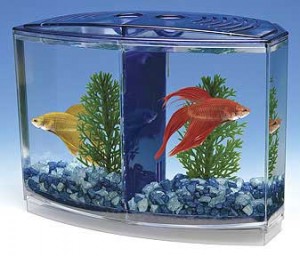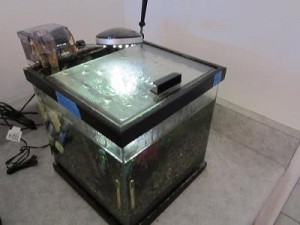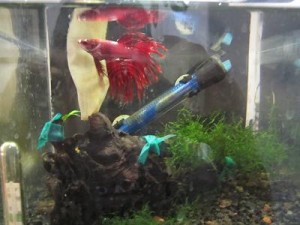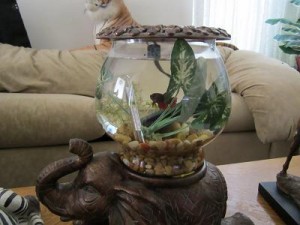You’ve seen them when you go to the store, the little fish in a cup. The betta is a popular fish because it doesn’t need much space, can live alone with no problem, and can be found easily.
As a side note, the proper pronunciation is not “beta” like the Greek letter, but “bet-ta,” as in “make a bet.” So pervasive is the mispronunciation that most people will “correct” the person saying it properly.
Adequate Housing
The main thing I want to bring to the table here is the best environment for one of these fish. Often, near the stack of cups, you’ll find betta bowls like the one below.
While it may look nice, this is way too small for this fish. Bettas deserve to have filtered water, some heat in the winter, and enough room to swim. That’s not to say a betta can’t be kept in a bowl. They can, but with some caveats. More about that later.
A Good Environment
The best possible environment for a betta is a tank of a couple of gallons. The photo below shows one of my betta tanks.
Note some of the hardware you see that don’t appear in most betta setups. There is a light, in this case a small LED desk lamp. There is a heater and thermometer. In wintertime, room temperature tends to be too cold for bettas, who prefer water around 80 degrees Fahrenheit. There is a filter. That’s right, a filter. This is a small Japanese hang-on-back model that has excellent flow adjustment capability. I keep it flowing so the water trickles down the back glass. A sponge filter is another good option. It has a lid, both to keep in heat and moisture, but also to keep Mojo in his tank.
Mojo also has a piece of driftwood covered in Java and Christmas moss. The moss helps to absorb waste. Mojo, by the way, is a male crowntail betta.
What About Bowls?
You will find a lot of opinion on this subject, especially from experienced fishkeepers. Despite the fact that most people keep a betta in a bowl, this is not an entry-level setup. Fish produce waste, and that becomes ammonia very quickly. Ammonia is toxic to fish.
Here is my female crowntail betta setup.
Java’s bowl is fairly large, probably over a gallon. Notice the bowl has a heater, a thermometer, and Java moss (to the left). The large leaf plant is fake, but it does provide her with cover. The rim around the top keeps her from jumping. What you don’t see here is a filter. What that means is that the human must be the filter.
I put this betta into a bowl to challenge my fishkeeping skills, not because I didn’t have anywhere else to put her. During the month when the bowl grew the beneficial bacteria to consume fish waste, I tested the water for ammonia content daily, and performed a 50% water change daily. Now that the bowl is cycled, I perform a 50% water change weekly. To keep a betta in a bowl healthy, the water changes cannot be compromised. They are mandatory.
Feeding
The other secret is to minimize the food offered. I give each betta just one or two flakes per feeding. That’s it. Overfeeding will allow ammonia to form as uneaten food breaks down. Overfeeding also promotes bloating, which can ultimately result in a dead fish.
Conclusion
There is very strong opinion about keeping bettas in bowls, and anyone who isn’t an experienced fishkeeper should get a full-blown system with heater and filtration. Even a 5-gallon tank is adequate. The bowls should be attempted only after a filtered system is successful, and only with the commitment to keep it clean without constantly stressing the fish by removing her. The larger the bowl, the better, as they do like to swim from time to time.








